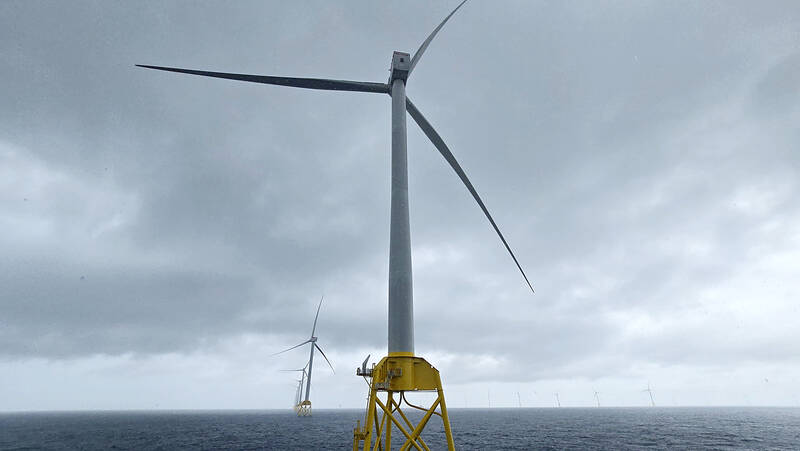Orsted Taiwan Ltd (沃旭能源) yesterday announced it has delivered first power from its 920-megawatt Greater Changhua 2b and 4 offshore wind farms, the first offshore project built to supply renewable energy to Taiwan Semiconductor Manufacturing Co (台積電).
The wind farms, located 35 to 60 kilometers off the coast of Changhua County in western Taiwan, will eventually consist of 66 Siemens Gamesa Renewable Energy SA 14-236 turbines, each with a capacity of 14 megawatts, the company said in a statement.
Jayaram Naidu, managing director of the Greater Changhua offshore wind project, said in the statement that achieving first power within just three months of installing the first subsea foundation in April demonstrates Orsted’s “strong project execution” capabilities.

Photo courtesy of Orsted Taiwan Ltd
“Despite ongoing challenges in the global wind industry, we’ve stayed on course by working closely with our suppliers and contractors,” Naidu said.
“This milestone marks the beginning of the next phase — safely completing construction, energizing additional wind turbines, and progressing steadily toward full commercial operation,” he said.
Orsted Taiwan chairperson Christy Wang (汪欣潔) said the milestone is significant for the company and “reaffirms Taiwan’s leadership in offshore wind across the Asia-Pacific region.”
“All of the renewable energy generated by the 920 MW wind farms will be supplied to TSMC through our 20-year corporate power purchase agreement, aiding our corporate customer in advancing its climate action and sustainability goals,” Wang said.
The project has progressed rapidly since a final investment in it was made in March 2023, with all 66 suction bucket jacket foundations and 32 turbines already installed, the statement said.
Two onshore substations and one offshore substation have been energized, and undersea cable laying is continuing on schedule, it added.
The project is the first in Taiwan to employ piling-free suction bucket jacket foundations, which Orsted said generate almost no noise during installation and can be fully removed at the end of the wind farm’s operational life, reducing potential impact on marine ecosystems.
The Greater Changhua 2b and 4 wind farms follow the company’s 900 MW Greater Changhua 1 and 2a project, which began operations in April last year.
Once the new wind farm is fully operational, Orsted’s total installed offshore wind capacity in Taiwan will reach 1.82 gigawatts — enough to power approximately 2 million households and reduce carbon dioxide emissions by 3.5 million metric tons annually, the company said.
The Denmark-based renewable energy company added that this will make it the largest contributor to Taiwan’s offshore wind capacity to date.

GROWING OWINGS: While Luxembourg and China swapped the top three spots, the US continued to be the largest exposure for Taiwan for the 41st consecutive quarter The US remained the largest debtor nation to Taiwan’s banking sector for the 41st consecutive quarter at the end of September, after local banks’ exposure to the US market rose more than 2 percent from three months earlier, the central bank said. Exposure to the US increased to US$198.896 billion, up US$4.026 billion, or 2.07 percent, from US$194.87 billion in the previous quarter, data released by the central bank showed on Friday. Of the increase, about US$1.4 billion came from banks’ investments in securitized products and interbank loans in the US, while another US$2.6 billion stemmed from trust assets, including mutual funds,

Micron Memory Taiwan Co (台灣美光), a subsidiary of US memorychip maker Micron Technology Inc, has been granted a NT$4.7 billion (US$149.5 million) subsidy under the Ministry of Economic Affairs A+ Corporate Innovation and R&D Enhancement program, the ministry said yesterday. The US memorychip maker’s program aims to back the development of high-performance and high-bandwidth memory chips with a total budget of NT$11.75 billion, the ministry said. Aside from the government funding, Micron is to inject the remaining investment of NT$7.06 billion as the company applied to participate the government’s Global Innovation Partnership Program to deepen technology cooperation, a ministry official told the

Taiwan Semiconductor Manufacturing Co (TSMC, 台積電), the world’s leading advanced chipmaker, officially began volume production of its 2-nanometer chips in the fourth quarter of this year, according to a recent update on the company’s Web site. The low-key announcement confirms that TSMC, the go-to chipmaker for artificial intelligence (AI) hardware providers Nvidia Corp and iPhone maker Apple Inc, met its original roadmap for the next-generation technology. Production is currently centered at Fab 22 in Kaohsiung, utilizing the company’s first-generation nanosheet transistor technology. The new architecture achieves “full-node strides in performance and power consumption,” TSMC said. The company described the 2nm process as

Even as the US is embarked on a bitter rivalry with China over the deployment of artificial intelligence (AI), Chinese technology is quietly making inroads into the US market. Despite considerable geopolitical tensions, Chinese open-source AI models are winning over a growing number of programmers and companies in the US. These are different from the closed generative AI models that have become household names — ChatGPT-maker OpenAI or Google’s Gemini — whose inner workings are fiercely protected. In contrast, “open” models offered by many Chinese rivals, from Alibaba (阿里巴巴) to DeepSeek (深度求索), allow programmers to customize parts of the software to suit their